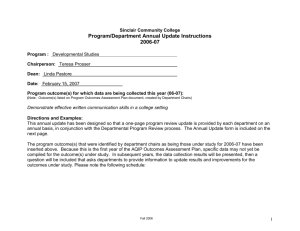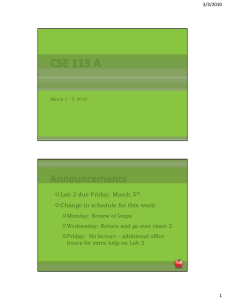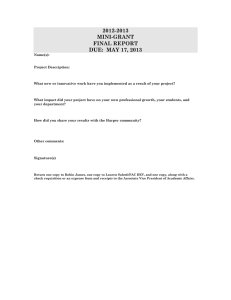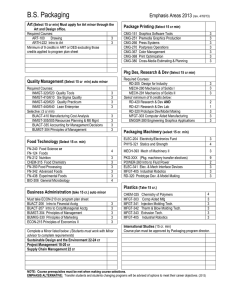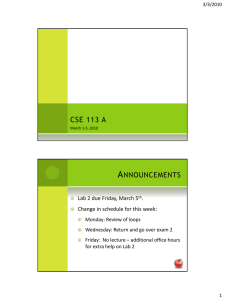7101 COMMERCIAL STUDIES MARK SCHEME for the October/November 2007 question paper
advertisement
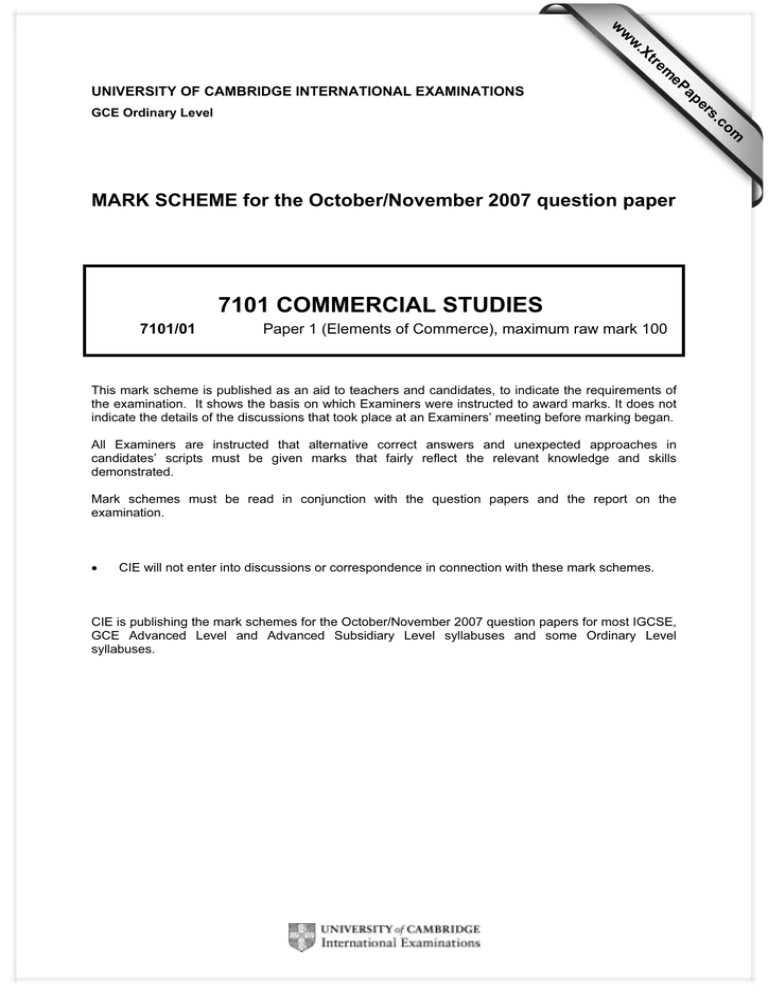
w w ap eP m e tr .X w UNIVERSITY OF CAMBRIDGE INTERNATIONAL EXAMINATIONS s er om .c GCE Ordinary Level MARK SCHEME for the October/November 2007 question paper 7101 COMMERCIAL STUDIES 7101/01 Paper 1 (Elements of Commerce), maximum raw mark 100 This mark scheme is published as an aid to teachers and candidates, to indicate the requirements of the examination. It shows the basis on which Examiners were instructed to award marks. It does not indicate the details of the discussions that took place at an Examiners’ meeting before marking began. All Examiners are instructed that alternative correct answers and unexpected approaches in candidates’ scripts must be given marks that fairly reflect the relevant knowledge and skills demonstrated. Mark schemes must be read in conjunction with the question papers and the report on the examination. • CIE will not enter into discussions or correspondence in connection with these mark schemes. CIE is publishing the mark schemes for the October/November 2007 question papers for most IGCSE, GCE Advanced Level and Advanced Subsidiary Level syllabuses and some Ordinary Level syllabuses. Page 2 Mark Scheme GCE O LEVEL – October/November 2007 Syllabus 7101 Paper 01 Section A 1 (a) (i) Obtaining raw material (1) from land or sea (1) are extractive (1) example (1) [2] (ii) Turns raw materials (1) into finished goods (1) in a factory (1) example (1) [2] (iii) Commerce (1) example (1) Direct services (1) example (1) [2] (iv) Those things not essential to survival or do not need (1) but which make life more pleasant/comfortable (1) example (1) (b) Goods are tangible things or products or visibles (1) e.g. food (1) Services are intangibles or invisibles (1) e.g. entertainment (1) [4] (c) Selling goods abroad provides foreign currency (1) + dev. Wider market for goods (1) + dev. Mass production possible/economies of scale (1) + dev. Creates employment (1) + dev. Increases standard of living (1) + dev. Friendship/political reasons (1) + dev. Economic growth (1) + dev. Balance of payments (1) + dev. Any 4 x 1 marks or 2 x 1 (partial answers) or 2 x 2 (developed answers) marks [4] (d) Cheaper for other countries to produce (1) + dev. Cannot be produced to the same quality (1) + dev. Some of the raw materials do not occur naturally (1) + dev. Comparative advantage (1) + dev. As car industry is multinational (1) – it can make components in one country and assemble in another (1) Any 4 x 1 marks or 2 x 2 marks 2 [4] (a) (i) Customers serve themselves or put goods into basket/trolley (1) [1] (ii) Advantages (allow retailer advantages only): Sales increase Less wage costs Impulse buying Disadvantages: Converting shops can be expensive Some customers prefer counter service Pilfering may occur Security costs Any 3 x 1 marks (Max of 2 marks for either advantage or disadvantage) © UCLES 2007 [3] Page 3 Mark Scheme GCE O LEVEL – October/November 2007 Syllabus 7101 Paper 01 (b) Personal or friendly service (1) Shop near customer’s home (1) Shop may be open longer (1) Informal credit (1) specialist advice (1) Good position in town (1) for many customers (1) bargaining (1) Any 1 x 4 marks or 2 x 2 marks [4] (c) Bulk buying (1) + dev. Own branding (1) + dev. Specialist buying (1) + dev. Fewer staff (1) + dev. Technical economies of scale (1) + dev. Quick turnover (1) + dev. Popularity of self-service or one-stop shopping (1) + dev. Any 3 x 2 marks [6] (d) (i) Owned by partners or 2-20 (1) Owned by shareholders or 2-50 (1) 3 [2] (ii) Unlimited liability for partnership (1) Limited liability for company (1) [2] (iii) Profits are normally shared equally in partnership or according to partnership deed (1) Profits dependent on amount invested in company (1) [2] (a) Factor – Sells the goods (1) Possesses the goods (1) Makes contracts in own name (1) Broker – Acts as agent (1) Does not possess the goods (1) Cannot arrange contracts in own name (1) [2] (b) To increase sales To encourage bulk buying To get rid of stock To obtain early payment Maintain goodwill Any 2 x 1 marks [2] (c) Store goods (1) until required by market (1) Store raw materials (1) + dev. Protection (1) against theft/weather/damage (1) Meet seasonal demand (1) E.g. (1) Maintain supplies (1) throughout the year (1) Avoids fluctuation of prices (1) + dev. Bonded warehouses (up to 4 marks) Allows time to pack, grade etc. (1) + dev. (1) Used for display (1) + dev. Cold storage (1) keeps goods fresh (1) (Note: If answer solely on home trade = 4 marks max.) © UCLES 2007 [2] [8] Page 4 Mark Scheme GCE O LEVEL – October/November 2007 Syllabus 7101 Paper 01 (d) (i) Revenue collection (1) + dev. Collection of statistics (1) + dev. Control of bonded warehouses (1) + dev. Prevent smuggling or prohibited goods (1) + dev. Quarantine (1) + dev. Quotas or Embargoes (1) + dev. Any 2 x 2 marks (ii) Excise duty – are on goods produced in own country (1) to discourage home consumption e.g. tobacco, alcohol (1) 4 [4] [2] (a) (i) Loan or overdraft (1) description (1) (ii) Night safe (1) description (1) (iii) Cash dispenser or ATM (1) description (1) (iv) Standing order or direct debit (1) description (1) [8] (b) Can bank 24/7 (1) No need to go to bank/can be done from home (1) Can obtain benefits from having an internet account (1) e.g. higher interest (1) check statements (1) pay bills (1) Any 2 x 1 marks [2] (c) (i) Amounts are usually large (1) + dev. Firms do not want to keep large amounts on premises (1) + dev. Cash is insecure/can be stolen (1) + dev. Costly to send through post (1) + dev. Provides record of payment (1) + dev. Creditors may refuse cash (1) + dev. Use of internet banking (1) + dev. Any 2 x 2 marks or 4 x 1 marks [4] (ii) Acts as guarantee that the cheque will be honoured (1) up to an amount (1) e.g. of amount (1) [2] (iii) Credit card is a means of buying on credit/in shops (1) + dev. (1) Credit card is paid off with monthly statement (1) whereas cheque guarantee by a cheque card is paid quickly (1) No need for current account with credit card (1) cheque card linked to current account (1) [4] © UCLES 2007 Page 5 5 Mark Scheme GCE O LEVEL – October/November 2007 Syllabus 7101 Paper 01 (a) (i) Dial directly or call (1) and speak to person (1) E.g. (1) [2] (ii) Talk to one (1) to pass information or demonstrate (1) E.g. (1) [2] (iii) Can be sent by first or second class (1) or airmail (1) Use of postcodes (1) Need for written information (1) [2] (b) Emailing (1) explanation (1) Use of Internet (1) explanation e.g. ordering online (1) Wider market (1) over most parts of the world (1) Access any time (1) 24/7 (1) Less use of traditional methods (1) example (1) Efficiency reasons (1) + dev. (1) [4] (c) Inform (1) of new goods (1) Persuade (1) to sell goods (1) Remind (1) to create brand loyalty (1) Advertise for new employees (1) + dev. [4] (d) (i) Adv. Local audience/kept for future reference/cheaper/can target audience/ detailed information Any 1 x 1 Disad. Lacks impact of TV/may not stand out with other adverts/illiteracy Any 1 x 1 Passing trade/cheap to produce/aimed at local audience Any 1 x 1 Disad. unsuitable for detailed information/likely to be ignored/needs people to pass shop and take notice Any 1 x 1 [1] [1] (ii) Adv. [1] [1] (iii) Adv. 6 Cheap to make/given out door to door or letter boxes/kept for future reference/can be detailed Any 1 x 1 Disad. Tend to be thrown away/difficult to target right audience/illiteracy Any 1 x 1 [1] (a) (i) Fast (1) over long distances (1) less risk of theft/damage (1) reduces warehousing/ packing costs (1) less insurance costs (1) [4] (ii) Expensive (1) to build (1) If one part of pipeline is damaged the whole pipeline cannot be used (2) Only limited types of goods can be used (1) [4] (iii) A – medical supplies, perishables, spare parts, expensive goods etc. (1) B – gas, oils, liquids etc. (1) [2] (b) (i) Vehicles driven around (1) seen by many people (1) Repetitive sightings (1) people remember the name etc. (1) to get in touch with the company by email (1) To see what the company offers on its website (1) Form of advertising (1) (ii) World wide web (2) (one mark for any two correct words) © UCLES 2007 [1] [2] [2] Page 6 7 Mark Scheme GCE O LEVEL – October/November 2007 Syllabus 7101 Paper 01 (c) (i) Accompanies goods (1) gives details of goods (1) signed by customer (1) as proof of delivery (1) [2] (ii) Accompanies goods sent by air (1) gives details of goods carried (1) acts as a receipt (1) gives value of goods for customs (1) gives consignor and consignee (1) [2] (iii) Acts as a receipt (1) evidence of contract (1) document of title (1) explanation of document of title (1) Used with sea transport (1) [2] (a) (i) 4800 (2) (one mark for correct method) (ii) The rate of thefts in the area (1) + dev. The amount of valuables or type of goods kept in warehouse (1) + dev. The purpose for which the warehouse is used (1) + dev. The previous insurance record of the building (1) + dev. Any 4 x 1 marks or 2 x 2 marks (b) (i) Employers’ liability or Workman’s compensation [2] [4] [1] (ii) Public liability [1] (iii) Fidelity guarantee [1] (iv) Consequential loss [1] (c) (i) Loss of profits or poor management or change of fashion or changes in law which affect business or tax changes or bankruptcy [1] (ii) Cannot be assessed (1) therefore premium cannot be calculated (1) owing to no past records/statistics (1) giving guide to possible losses (1) [3] (d) (i) Must tell the truth (1) disclosing all material facts (1) when completing a proposal form (1) so that premiums can be assessed (1). If form not filled in correctly the insurance may be declared void (1). [3] (ii) Legal (1) contract or agreement (1). Prepared by Insurer (1) between insured and insurer (1) setting out details/terms/rules (1) example of cover (1). [3] © UCLES 2007


